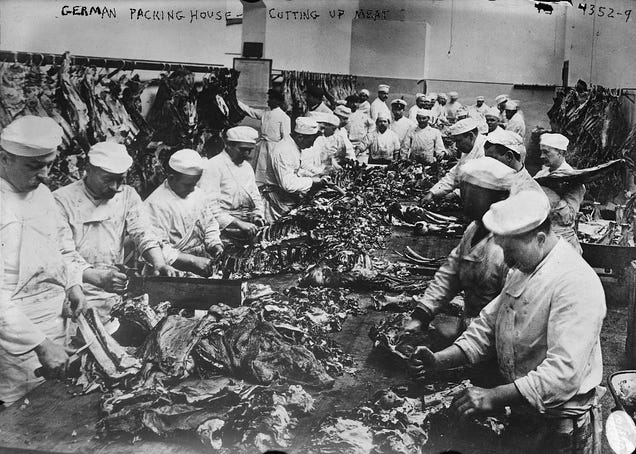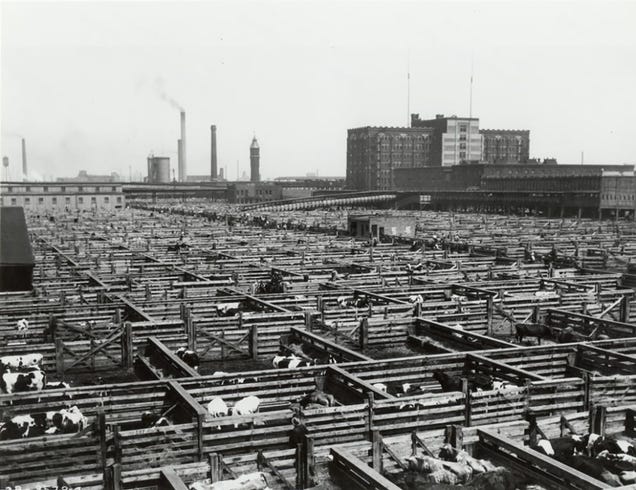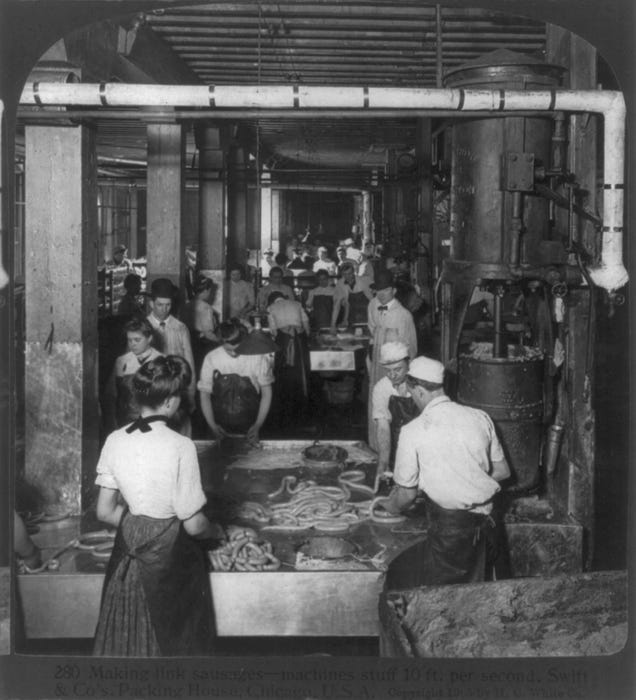
Gabrielle Williams
Pools of blood, stale water, rotting meat; it sounds like something out of a horror movie. Unfortunately, it was the reality of the meatpacking industry in the early 1900's. Although some people today believe conditions in the food industry, specifically the meatpacking industry to be grotesque, it cannot compare to the horrid conditions found in the early 1900’s. Many of these conditions were exposed in the well known book “The Jungle” by Upton Sinclair. Up to that point , the people of the United States were not incredibly concerned or educated on the happenings in the meatpacking industry. “The Jungle”, however, helped to change all that.
 In the early 1900’s, conditions in the meatpacking industry were dangerous not only for the consumers but also for the workers. There were many potential hazards in the industry such as back injuries, knife cuts, infections, and falls. These hazards are still present today but are much less common that in the early 1900’s. Although “The Jungle” was supposed to be a novel recognized for the hardships in the United States for immigrants, readers were more appalled by the conditions of the meat factories. Sinclair visited meat factories in order to gather information for his book. The fact that the information provided in the book was a first hand account startled readers. Soon, rumours began to spread about people being caught in the machines only to be grounded up along with the rest of the meat. Immigrant men were usually in charge of the hard work. They worked in dark, unventilated rooms that were sweltering in the summer and freezing in the winter. They stood on their feet throughout the day in pools of blood, scraps of meat and stagnant water. Women and children who were over a certain age canned meat, trimmed, and made sausages. Nearly every part of the animal was used. The meat was canned, pickled, salted, smoked, etc. All of the other parts ended up as fertilizer or lard. Meat was shoveled into carts to be packaged and as men shoveled, they would often find rats inside of the meat. Instead of deeming the meat unfit for human consumption, they picked them out and continued on with the shoveling. There was no place for people to wash their hands and so they washed their hands in water that was to be put in with the sausages. This, obviously, further contaminated the already disgusting water. All of the sausage that was made was of the same quality but the workers would set some randomly aside and mark it as “special” and charge more for it. Meat was taken to be processed in barrels full of dirt, old nails, and rust. This is the meat that they were serving to the unknowing public.
In the early 1900’s, conditions in the meatpacking industry were dangerous not only for the consumers but also for the workers. There were many potential hazards in the industry such as back injuries, knife cuts, infections, and falls. These hazards are still present today but are much less common that in the early 1900’s. Although “The Jungle” was supposed to be a novel recognized for the hardships in the United States for immigrants, readers were more appalled by the conditions of the meat factories. Sinclair visited meat factories in order to gather information for his book. The fact that the information provided in the book was a first hand account startled readers. Soon, rumours began to spread about people being caught in the machines only to be grounded up along with the rest of the meat. Immigrant men were usually in charge of the hard work. They worked in dark, unventilated rooms that were sweltering in the summer and freezing in the winter. They stood on their feet throughout the day in pools of blood, scraps of meat and stagnant water. Women and children who were over a certain age canned meat, trimmed, and made sausages. Nearly every part of the animal was used. The meat was canned, pickled, salted, smoked, etc. All of the other parts ended up as fertilizer or lard. Meat was shoveled into carts to be packaged and as men shoveled, they would often find rats inside of the meat. Instead of deeming the meat unfit for human consumption, they picked them out and continued on with the shoveling. There was no place for people to wash their hands and so they washed their hands in water that was to be put in with the sausages. This, obviously, further contaminated the already disgusting water. All of the sausage that was made was of the same quality but the workers would set some randomly aside and mark it as “special” and charge more for it. Meat was taken to be processed in barrels full of dirt, old nails, and rust. This is the meat that they were serving to the unknowing public.
 After the public read “The Jungle”, the White House received a plethora of mail concerning the condition of the meatpacking industry. The people demanded that the president change the way it functioned. Up until that point, the inspection process for meat was subpar. Inspectors were only required to make sure the animal that was being killed was healthy at the time of it’s death. In “The Jungle”, the fact that rotten meat was being “freshened” with chemicals and sold under false pretenses to the American public became widely known. When investigating the claims that Sinclair made, a commission made by the White House found that the astounding number of claims he made were, in fact, true. While investigating, they witnessed part of a pigs carcass fall into one of the workers toilets. Instead of discarding the tainted meat, they simply plucked it out of the toilet and continued to go about the process of cutting it into meat for the public.
After the public read “The Jungle”, the White House received a plethora of mail concerning the condition of the meatpacking industry. The people demanded that the president change the way it functioned. Up until that point, the inspection process for meat was subpar. Inspectors were only required to make sure the animal that was being killed was healthy at the time of it’s death. In “The Jungle”, the fact that rotten meat was being “freshened” with chemicals and sold under false pretenses to the American public became widely known. When investigating the claims that Sinclair made, a commission made by the White House found that the astounding number of claims he made were, in fact, true. While investigating, they witnessed part of a pigs carcass fall into one of the workers toilets. Instead of discarding the tainted meat, they simply plucked it out of the toilet and continued to go about the process of cutting it into meat for the public.  Because of public outcry and the investigation, President Roosevelt decided to put a change to the way the meatpacking industry was run. On June 30, 1906 he signed the Meat Inspection Act. On that same day, he signed a law that said that food and drugs were required to be regulated. It was due to this that the meatpacking industry was finally regulated and began to become closer to what we know it as today. Although many of us still do not consider it to be extremely safe or sanitary, it is a stark improvement from it’s previous conditions. There was a saying in the meatpacking industry that went “we use everything except the squeal.” It is a definite relief “The Jungle” was written and the public reacted the way they did or else this saying would still be applicable today, which would really be something to squeal in horror about.
Because of public outcry and the investigation, President Roosevelt decided to put a change to the way the meatpacking industry was run. On June 30, 1906 he signed the Meat Inspection Act. On that same day, he signed a law that said that food and drugs were required to be regulated. It was due to this that the meatpacking industry was finally regulated and began to become closer to what we know it as today. Although many of us still do not consider it to be extremely safe or sanitary, it is a stark improvement from it’s previous conditions. There was a saying in the meatpacking industry that went “we use everything except the squeal.” It is a definite relief “The Jungle” was written and the public reacted the way they did or else this saying would still be applicable today, which would really be something to squeal in horror about.
Works Cited
"Conditions in Meatpacking Plants (1906, by Upton Sinclair)." Dictionary of American History. 2003. "Conditions in Meatpacking Plants (1906, by Upton Sinclair)." Encyclopedia.com. HighBeam Research, 01 Jan. 2003. Web. 23 Feb. 2015.
"Meat Packing - IHT 13:2 2006." Meat Packing - IHT 13:2 2006. N.p., n.d. Web. 23 Feb. 2015.
"Packing and Processing." The United Food and Commercial Workers International Union UFCW. N.p., n.d. Web. 23 Feb. 2015.
"Safety and Health Guide for the Meatpacking Industry." Safety and Health Guide for the Meatpacking Industry. N.p., n.d. Web. 23 Feb. 2015.
Sinclair, Upton. The Jungle. N.p.: n.p., n.d. Web.
"Upton Sinclair's The Jungle:Muckraking the Meat-Packing Industry." BRIA 24 1 B Upton Sinclairs The Jungle: Muckraking the Meat-Packing Industry. N.p., n.d. Web. 11 Feb. 2015.
"Utterly Disturbing, Century-Old Photos of Meat-Packing Facilities." Io9. N.p., n.d. Web. 23 Feb. 2015.
I was surprised that for so long there were no regulations on the meat industry. Was this because there were not many reports of people getting sick? I have never heard about anyone today complaining about the meat packing industry, so that fact was a little confusing to me.
ReplyDelete1) i found it interesting how the government, for so long, was unaware as to what was going on
ReplyDelete2) i am curious about the regulation of the industry and how closely the regulators pay attention and if they even do what they are supposed to be doing
3) Were there a lot of people getting sick because of how unsanitary the industry was?
1. The beginning of your paper stood out really well and made me very interested in your topic. I did not know that the people were so unsanitary while messing around with other people's food.
ReplyDelete2. I am curious to know if there were a lot of people complaining about getting sick after eating the meat.
3. Did the industries and the workers get some kind of punishment for being so unsanitary?
1.it was surprising to learn how completely nasty the factories were. So gross...
ReplyDelete2. im confused about why no one knew about the terrible conditions before the book came out
3. Why did Upton decide to write "The Jungle"?